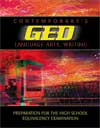|
 |  Contemporary's GED Language Arts, Writing Ellen Carley Frechette
Tim Collins
Organization
Chapter OutlineStudy the chapter outline below. Use the page numbers below each topic to refer to the corresponding section in Contemporary's GED Language Arts, Writing. When you are finished, go to the Flashcards or choose a different activity or chapter from the menu on the left.
Effective Paragraphs
(See pages 115 and 116)
A paragraph is a group of sentences that communicates one idea. The topic sentence states that main idea, and the other sentences in the paragraph provide supporting details for it.
The GED Language Arts, Writing Test asks you to make paragraphs more effective in several ways: -
inserting a topic sentence
-
dividing and combining paragraphs
-
rearranging and deleting sentences for clarity
-
maintaining consistent tone and diction
|
 |  |  | Inserting a Topic Sentence
(See pages 117–119)
-
The topic sentence is the sentence that best states the main idea of the other sentences in a paragraph.
-
Some of the questions on the GED Language Arts, Writing Test ask you to choose a topic sentence.
-
To answer this type of organization question, you need to read the given paragraph and understand its main idea.
|
 |  |  | Correcting Paragraphs
(See pages 120–126)
- Dividing Paragraphs
When a paragraph contains two main ideas, it needs to be divided into two paragraphs. Some questions on the GED Language Arts, Writing Test ask you to decide where a new paragraph should begin. - Rearranging or Combining Paragraphs
Sometimes a piece of writing will be more effective if sentences are moved around or combined with another paragraph.
|
 |  |  | Deleting Sentences
(See pages 127–131)
-
Sometimes a paragraph contains a sentence that does not contribute to the main idea and should be deleted.
-
Some questions on the GED Language Arts, Writing Test ask you to delete such a sentence.
|
 |  |  | Tone and Diction
(See pages 132 and 133)
-
The tone of a piece of writing is its general style: formal or casual, serious or upbeat, scholarly or for a general audience.
- Diction is word choice, which contributes greatly to tone.
-
Different tones are appropriate for different pieces of writing and different audiences, but the tone should stay the same within a piece of writing.
-
If a sentence has an inconsistent tone, it should be either deleted or rewritten to be consistent.
|
|
|



 2002 McGraw-Hill Higher Education
2002 McGraw-Hill Higher Education